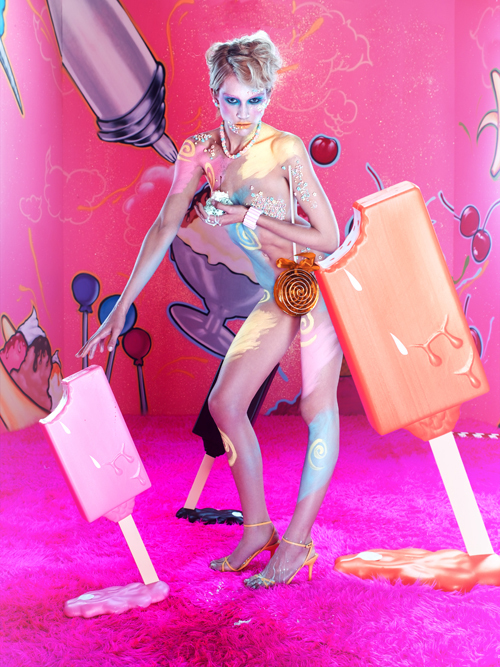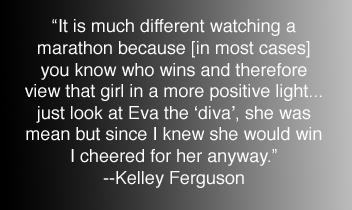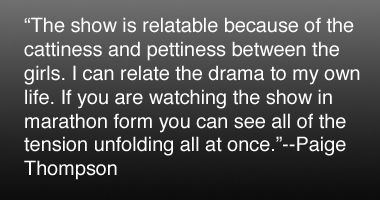
*Note: For this portion of this study, I routinely examined friends during the weekly ritual of watching America's Next Top Model (ANTM). I also examined people watching a recent marathon of Cycle 4 on MTV. The participants of this study were: Kelley Ferguson, Stephanie Agtarap, Sally Redden, Paige Thompson, Kelsey Horick, Kimberly Negoescu, Diana Leon, Abbie Garcia, Tim Wood, Alex Lannon, and Lance Lagerquist. Some were viewers of both the weekly airing and the marathon while others only watched the show during televised marathons.
Audiencing is an important factor in fully analyzing visual images. It is important to understand how people use visual images. Audiencing "treats visual images as objects
with which people do things" (Rose, 197). Visual images are not just images but as the term audiencing states--objects.
The images and meanings of each photograph on ANTM have a life as objects. In this case the photos are shown through the television medium and also online and therefore have different physical properties than the actual referent photograph.
When examining visual objects, three aspects are important: materiality, materialization, and mobility. In this case, we will study an image of Cycle 8 contestant Renee (shown below).

In materiality, the look/feel, age, weight, texture, etc. are examined. In this example we can only tell what the image is of. Materialization is what the image does and what is done with the image. In this case the image depicts Renee as she represents ice cream. The image intrigues the viewer and captures their attention. The photo could remind the viewer of their favorite type of ice cream, and has the ability to take them back to a personal memory. This image is used to create a connection to the audience not only through eye contact but also through a shared love of this dessert. Mobility is the most important factor in the case of photos like this one. Mobility deals with how a visual object travels, through what means, and what happens to it in the constant process of moving to change what the image means to the viewer. In the case of the virtual objects from ANTM, they travel to a vast audience through the mediums of television and the Internet. When different people view the photo, online for example, the picture takes on new meaning is recontextualized as they are modified by a new set of eyes and personal beliefs. The images all start off as images on the television, but when they are placed online they take on a new mobility and a new materiality if you printed the image off. For example on paper the texture is smooth and lightweight or it could be glossy and shiny if on photo paper (Rose, 219-225).
| The audience takes in the visual images and mentally process and use them in a variety of ways. In the case of ANTM, there are two different ways to be exposed to these images through the weekly program (aired Wednesdays at 7pm) and all day marathons. Under these two different circumstances, people view the show, its images, and meanings in distinct ways. |  |
|
| During the weekly airing of the show, the group is comprised of all girls. They tune into channel 12 a few minutes before 7:00pm every week. If it is not watched at this time, the group watches it on Tivo which itself has certain viewing rituals to be discussed later. At the weekly viewing, as the girls focus on the show, they multitask. Some are cooking dinner, others are drinking, but none are doing activities that take up too much of their precious attention such as homework. | ||
 |
For a group of women, the room is surprisingly quiet that is until the commercials air and everyone begins to vocalize their opinions of the last segment of the show and predict who is going home at the end of the episode. When ANTM is watched on Tivo however, the episode is paused for people to voice their opinions and all of the commercials are skipped. The ritual of eating and drinking or doing things models would never do applies to both viewing experiences. |
Another form of viewing experience is during a marathon. This has a very different viewership because people are focused on other things than just the episode. In this case, the audience does homework, cleans, takes naps, cooks (or orders pizza) and even talks non-stop during the episode. When watching a cycle over again in marathon form the audience still makes predictions about who is going home, even if they have seen the episode previously. Recently Cycle 7 was aired on both VH1 and MTV within the same week and the group watched it none-the-less. In this case the show is used as background noise instead of being focused on for an hour.

In the case of the weekly airings on Wednesdays, women also use the show as a style guide in which the techniques learned from the show are adapted and used for getting ready to go out for the night. The show influences how the group dresses and does their hair and makeup. The visual objects are used to influence the women's physical appearance more than their demeanor. There is in this case a clear correlation between audiencing and discourse.